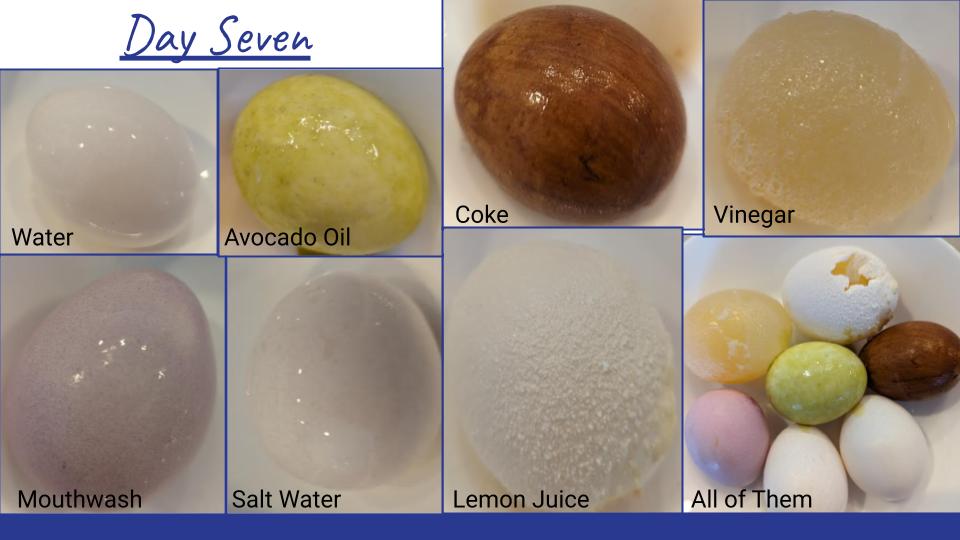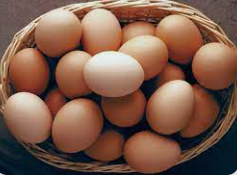Evelyn's Eggcellent Eggsperiment.
Grade 5
Presentation
No video provided
Hypothesis
My hypothesis is that:
- The sugary liquids will start to break down the egg shell because I have heard that sugar eats away at your teeth. It would also be heavier, change color, and become weaker.
- The acidic liquids will fully disintegrate the shell because I know that acid is good at dissolving. When you dip an egg in vinegar, the shell dissolves, leaving the inner semi-permeable membrane intact. Vinegar ( the acid ) breaks apart the shell ( the base ) and the eggshell into their calcium and carbonate parts.
- The colorful liquids will stain the egg shell because the color will start to eat into the shell and stain it. I should see the coloured water pass into the egg ( slowly ).
Research
I learned that eggshells have a similar chemical composition to our tooth enamel, making them react similarly with other chemicals. This can help us understand what stains teeth and how to protect them. Eggshells contain mostly composite calcium carbonate, with some calcium phosphate and tooth enamel is a composite calcium phosphate.
Variables
Dependent Variable: How decayed the eggs are after a week.
Independent Variable: The liquid I am putting the eggs in.
Control Variable: The amount of liquid, size and type of the eggs, the glass/cup, and the time I am leaving the eggs in for.
Procedure
- Lay out seven glasses.
- Pour a cup of the different liquids into each glass. (Lemon Juice, Avocado Oil, Salt Water, Mouthwash, Vinegar, Coke, Water.)
- Carefully drop an egg into each cup.
- Observe everyday for a week.
- After a week, take the eggs out and note and observe what they look and feel like.
Observations

- The lemon egg turned slimy.
- Small bumps formed on the lemon eggs shell.
- The bottom half of the lemon eggs glass was foam.
- The lemon egg doubled in size.
- Starting on day 3 the lemon egg hovered in the middle.
- There were small purple dots on the mouthwash shell.
- A slimy pink film developed on the mouthwash egg.
- On day 7, mold developed on the coke eggs shell and glass
- By day 3 there were thin, paper-like spots on the coke egg shell.
- The entire coke egg was stained light brown.
- The vinegar egg became slimy and slippery.
- As soon as I put the vinegar egg in, it was completely covered in bubbles.
- The vinegar shell dissolved entirely.
- The vinegar egg doubled in size.
- By day 2 the vinegar was floating to the top of the glass.
- On day 7 the vinegar egg was clear. (I could see the yolk).
- At the end, the vinegar egg was rubbery and bouncy.
- After a few minutes the avocado egg had a neon green coating that could easily be wiped.
- On day 3 there was a slimy green layer on the avocado egg shell.
- There were a few bubbles on the salt water eggs shell.
- Nothing happened to the salt water egg.
- There were a couple of bubbles on the water egg shell.
- The water egg stayed the same.
Analysis
I was suprised to see that the lemon egg still had the shell. It was just very weak. I thought it would be fully dissolve like the vinegar egg did. Though I did predict to see colourful stains on the coke, mouthwash, and avocado oil eggshells. I also predicted that the water and salt water eggs wouldn't change other than a few bubbles.
Conclusion
My conclusion for the acidic eggs is that they both grew a lot in size and the shell dissolved in some way. However the vinegar eggs shell completely dissolved, where the lemon egg got VERY fragile and built up layers of crust.
My conclusion for the oil egg is that it got stained a tiny bit, but you could wipe off most of it.
My conclusion for the water and salt water is that they don’t decay or stain your teeth.
My conclusion for the sugary liquid eggs (coke and mouthwash) is that the eggs got stained because of the color. The sugar itself didn't do any damage. My hypothesis about the sugar was wrong so I did some extra research. I learned that sugar doesn't do any damage to your teeth. It just feeds the bacteria in your mouth which then produces acid that slowly decays your teeth making cavities. That's why the eggs still stayed strong.
Application
This data is important in real life because you can better understand the impacts on your teeth if you don’t brush.
Sources Of Error
If I were to improve this experiment I would make 2 vinegar eggs, 2 coke eggs and 2 lemon juice eggs. Every day I would brush 1 of each egg for a week. This way I could see the difference.
Citations
Acknowledgement
I would like to thank Mariola Jedrusiak (My grandma) for being an expert on teeth. She gave me the idea for this project and some background information from being a dental hygenist.
Attachments
No Log Book Provided
View Extra Attachment: report/data/exhibit/etc(may download a file)

